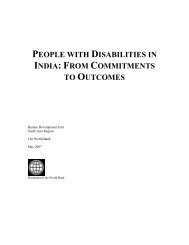FREE Download - TARSHI
FREE Download - TARSHI
FREE Download - TARSHI
You also want an ePaper? Increase the reach of your titles
YUMPU automatically turns print PDFs into web optimized ePapers that Google loves.
Formal and informal policies emanating from institutional gate keepers and power centres, e.g. religious<br />
authorities, educational institutions, medical science and the legal machinery, define to a large extent<br />
what is considered 'normal' or 'deviant' in terms of sexual behaviour and identity. Links need to be made<br />
between social policies on the one hand and behaviour, perception, attitude and desire on the other,<br />
in order to develop both a body of theoretically grounded knowledge of sexualities and their construction,<br />
as well as to develop strategic interventions (Petchesky, 2000)<br />
Research on sexuality is also required for application to the development of health services. In the era<br />
of the HIV/AIDS pandemic and the post ICPD agenda of furthering the reproductive health approach,<br />
based on, among other things, the principles of gender equity and sexual and reproductive rights,<br />
sexuality research needs to lead policy planners and programme managers to the development of sound<br />
sexual health programmes. For example, research is required to examine health care providers' notions<br />
of sexuality and not just those of users or clients. Research may also evaluate different approaches<br />
to the sexuality training of health care providers. Research is also required to develop new strategies<br />
for women's empowerment e.g. on how women resist violence.<br />
Much of the analysis of sexuality emanating from the fields of cultural studies and anthropology over the<br />
past decade has focused on the role of symbolic representations and popular culture (film, television,<br />
advertising, music, the internet) in constructing sexual identity and desire across age groups, classes,<br />
genders and ethnicities. In India too, such cultural analyses clearly exist and indicate that it is not only<br />
adolescents who are susceptible to T.V. and movie images (John and Nair, 2000). However, most of the<br />
researchers whose studies are reviewed in this compilation, true to their behavioural and biomedical<br />
bias, seem not only unaware of any literature outside their immediate discipline but also uninterested in<br />
the effects of popular culture and media in constituting the changing meanings of sexuality. In the few<br />
cases where such effects are mentioned (Sharma and Sharma, 1998), the connections they make fail<br />
to consider intersecting structural factors such as class and income that restrict access to certain media,<br />
or different housing conditions and how they affect the possibility of privacy.<br />
Future research must examine the differences and power relations of class, caste, social roles and their<br />
intersections with gender and sexuality. While several of the studies do address issues of power<br />
relations between women and men in negotiating sexuality and sexual behaviour, there is hardly any<br />
focus on other power relations and social divisions as they may construct both coercive and consensual<br />
sex in India, much less on how these relations intersect with gender divisions. There seems to be an<br />
unquestioned assumption that cross-class and above all cross-caste sexual relations in India - whether<br />
heterosexual or homosexual, consensual or coercive - are taboo, yet none of the studies reviewed<br />
examines the validity of this assumption, especially with regard to issues of sexual domination and<br />
violence (for example, the rape of Dalit women by upper-caste men). Nowhere do the studies address<br />
sexual relations between adults and children within families (i.e.incest). Moreover, there appear to be<br />
few comparative studies that explicitly focus on differences in sexual meanings, object choice, identity<br />
and desire as well as behavious, across class, caste, community, urban and rural populations or<br />
geographical area (Petchesky, 2000).<br />
Theory and practice in sexuality research: In a majority of the studies reviewed, the conceptual<br />
models have tended to view sexuality through the lenses of biomedicine and epidemiology, casting it in<br />
terms of pathology and "high risk groups." As a result, most of these studies miss the most innovative<br />
aspects of the new scholarship on sexuality. Future research in the area of sexuality should be based<br />
on both multidisciplinary and multisectoral approaches. There is a need to combine the bio-medical with<br />
the social sciences and the rights approaches. Attempts should also be made to generate indigenous<br />
theories of sexuality rather than merely applying existing theoretical frameworks to sexuality studies.<br />
It would be helpful if future research proposals could incorporate critiques of conventional theoretical<br />
models. In addition, they could explicitly state the paradigms that their research is based on and ensure<br />
20










